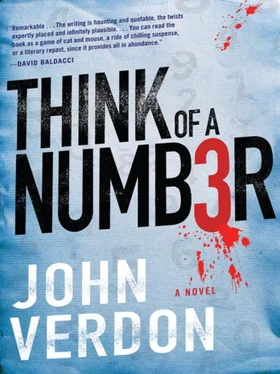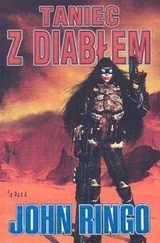“How?” asked Blatt, mystified.
“When he was getting the deck ready in the beginning, just before he fanned the cards out, he’d manage to identify at least one card and then control its position in the fan.”
“Suppose no one picked it?” asked Holdenfield, intrigued.
“If no one picked it, he’d find a reason to discontinue the trick by creating some sort of distraction-suddenly remembering he had the kettle on for tea or something like that-so no one would realize there was a problem with the trick itself. But he almost never had to do that. The way he presented the fan-out, the first or second or third person he offered it to almost always picked the card he wanted them to. And if not, he’d just do his little kitchen routine, then come back and start the trick over. And of course he always had some perfectly plausible way of eliminating the people who’d picked the wrong cards, so no one would realize what was actually going on.”
Rodriguez yawned. “Is this somehow related to the six fifty-eight business?”
“I’m not sure,” said Gurney, “but the idea of someone thinking he’s picking a card at random, while the randomness is actually being controlled-”
Sergeant Wigg, who had been listening with increasing interest, broke in. “Your card trick story reminds me of that private-eye direct-mail scam back in the late nineties.”
Whether it was due to her unusual voice, pitched in the register where male and female overlap, or to the unusual fact that she was speaking at all, she captured everyone’s instant attention.
“The recipient gets a letter, supposedly from a private-investigation company, apologizing for invading the recipient’s privacy. The company ‘confesses’ that in the course of a botched surveillance assignment they mistakenly followed this individual for several weeks and photographed him in various situations. They claim that they are required by privacy legislation to give him all the existing prints of these photos. Then comes the curveball question: Since some of the photos seem to be of a compromising nature, would the recipient like them sent to a post-office box rather than to his home? If so, he will need to send them a fifty-dollar fee to cover the additional record keeping.”
“Anyone stupid enough to fall for that deserves to lose fifty dollars,” sneered Rodriguez.
“Oh, some people lost a lot more than that,” said Wigg placidly. “It wasn’t about getting the fifty-dollar payment. That was only a test. The scammer mailed out over a million of those letters, and the only purpose of the fifty-dollar request was to develop a refined list of people guilty enough about their behavior that they wouldn’t want photos of their activities to fall into the hands of their spouses. Those individuals were then subjected to a series of far more exorbitant requests for payments related to the return of the compromising photographs. Some ended up paying as much as fifteen thousand dollars.”
“For photos that never existed!” exclaimed Kline with an amalgam of indignation and admiration for the scammer’s ingenuity.
“The stupidity of people never ceases to amaze-” began Rodriguez, but Gurney interrupted him.
“Jesus! That’s it! That’s what the two-hundred-eighty-nine-dollar request is. It’s the same thing. It’s a test!”
Rodriguez looked baffled. “A test of what?”
Gurney closed his eyes to help him visualize the letter Mellery had received asking for the money.
Frowning, Kline turned to Wigg. “That con artist-you said he mailed out a million letters?”
“That’s the number I recall from the press reports.”
“Then obviously this is a very different situation. That was basically a fraudulent direct-mail campaign-a big net thrown out to catch a few guilty fish. That’s not what we’re talking about here. We’re talking about handwritten notes to a handful of people-people for whom the number six fifty-eight must have had some personal meaning.”
Gurney slowly opened his eyes and stared at Kline. “But it didn’t. At first I assumed it did, because why else would it come to mind? So I kept asking Mark Mellery that question-what did the number mean to him, what did it remind him of, had he ever thought of it before, had he ever seen it written, was it the price of something, an address, a safe combination? But he kept insisting the number meant nothing to him, that he never remembered thinking of it before, that it simply popped into his mind-a perfectly random event. And I believe he was telling the truth. So there has to be another explanation.”
“So that means you’re back where you started,” said Rodriguez, rolling his eyes with exaggerated weariness.
“Maybe not. Maybe Sergeant Wigg’s con game is closer to the truth here than we think.”
“Are you trying to tell me that our killer sent out a million letters-a million handwritten letters? That’s ridiculous-not to mention impossible.”
“I agree that a million letters would be impossible, unless he had an awful lot of help, which isn’t likely. But what number would be possible?”
“What do you mean?”
“Let’s say our killer had a scheme that involved sending out letters to a lot of people-handwritten, so each recipient would get the impression that his letter was a one-of-a-kind personal communication. How many letters do you think he could write in, say, one year?”
The captain threw up his hands, intimating that the question was not only unanswerable but frivolous. Kline and Hardwick looked more serious-as if they might be attempting some kind of calculation. Stimmel, as always, projected amphibian inscrutability. Rebecca Holdenfield was watching Gurney with growing fascination. Blatt looked like he was trying to determine the source of a foul odor.
Wigg was the only one to speak. “Five thousand,” she said. “Ten, if he were highly motivated. Conceivably fifteen, but that would be difficult.”
Kline squinted at her with lawyerly skepticism. “Sergeant, these numbers are based on what, exactly?”
“To begin with, a couple of reasonable assumptions.”
Rodriguez shook his head-implying that nothing on earth was more fallible than other people’s reasonable assumptions. If Wigg noticed, she didn’t care enough to let it distract her.
“First is the assumption that the model of the private-eye scam is applicable. If it is, it follows that the first communication-the one asking for money-would be sent to the most people and subsequent communications only to people who responded. In our own case, we know that the first communication consisted of two eight-line notes-a total of sixteen fairly short lines, plus a three-line address on the outer envelope. Except for the addresses, the letters would all be the same, making the writing repetitive and rapid. I would estimate that each mailing piece would take about four minutes to complete. That would be fifteen per hour. If he devoted just one hour a day to it, he’d have over five thousand done in a year. Two hours a day would result in close to eleven thousand. Theoretically, he could do a lot more, but there are limits to the diligence of even the most obsessed person.”
“Actually,” said Gurney with the dawning excitement of a scientist who finally sees a pattern in a sea of data, “eleven thousand would be more than enough.”
“Enough to do what?” asked Kline.
“Enough to pull off the six fifty-eight trick, for one thing,” said Gurney. “And that little trick, if it was done the way I’m thinking it was done, would also explain the $289.87 request in the first letter to each of the victims.”
“Whoa,” said Kline, raising his hand. “Slow down. You’re going around the corners a little too fast.”
Читать дальше












